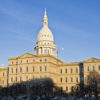Scott Hickle Guest Post: The Real Immigration Crisis
The following is a guest post and part of New American Economy’s effort to share ideas from other organizations and voices who are advocating for immigration reform.
Date: January 23, 2019
Given that 54 percent of our federal discretionary spending is allocated to national security, the tie between our economy and military strength is pronounced.1 The degree to which immigration underpins both is substantial and underrated. We are right to be discussing an immigration crisis, but we are looking the wrong way.
With a nominal GDP of almost $21 trillion, 2018 ended with America as the world’s largest economy by a significant margin. The Chinese economy, second in size with a GDP of about $13.5 trillion, appears almost quaint by comparison.2 Many Americans tacitly assume and behave as if this were the natural order. Growth rates, however, tell a less comforting story. While American GDP grew at approximately 3 percent in 2018, growth is projected to slow to a rate of 2 percent or less by 2020. China’s GDP is growing at around 6.5 percent and is projected to continue at a clip of 6 percent or more.3 Based on these numbers, China is poised to surpass the United States as the largest global economy in 11 years, by 2030. Maybe sooner.
These implications give me pause for America’s future. I worry that a cocktail of myopic policies in education and immigration have placed the United States on a path to relinquish our status as the world’s largest economy and preeminent superpower. Prominent economist Tyler Cowen argues that our nation is resting on its laurels; we have become complacent. I hope it does not take relegation on the world stage to rekindle our spirit. We will not enjoy being number two.
Given the alarming timeline, I wonder in earnest: can we maintain our global economic stronghold? I like to believe we can, but doing so will require a better educated and more productive American labor market. Our workforce is the basis of our economic engine. Our Department of Defense is staffed from the same pool. The economy fuels our defense spending; earning power and global power are inextricably linked.
We should refactor our education system to better surface and support our most gifted students. Unbiased meritocracy is our surest path to success. It is too late, though, to look for salvation in education policy, where there is a long lead time. A Chinese proverb comes to mind: the best time to plant a tree was twenty years ago. The second best time is now. There is much we can improve, and we should, but we cannot rely on changes in education today to have the desired effects to our economy and our military in time to maintain our competitive position.
To retain our global station for the decades to come, smart immigration reform is our only realistic option.
We need an immigration policy that is more welcoming of highly skilled immigrants. America has one tried and true Hail Mary to boost our anemic GDP growth: we must open our doors the best and brightest from every corner of the globe. If we do this effectively, it is reasonable to forecast our GDP growth could go to 5 percent or more. Maintained, that would preserve our position for upwards of 40 years. Personally, I want my children to live in an America that continues to be a beacon of innovation and economic vitality.
There are countless examples of best-in-class American companies founded by immigrants, iconic enterprises including PayPal, SpaceX & Tesla, WhatsApp, Pepsi, Yahoo, Intel, Pfizer, AT&T, Capital One, even Fox News. 43 percent of companies in the 2017 Fortune 500 were founded by a first- or second-generation immigrant.4 For comparison, first-generation immigrants comprise only 13.2 percent of the American population.5
America is foundationally a nation of immigrants. It is our birth, our proud heritage, and has historically been our greatest strength. We won World War II due to the work of scientist refugees on the Manhattan Project. Father of the atomic bomb, Robert Oppenheimer, was a second-generation immigrant. We won the Space Race because Wernher Von Braun and his colleagues were brought to America postwar by Secretary of State Cordell Hull. These immigrants went on to design the Saturn V rocket that put Neil Armstrong and Buzz Aldrin on the moon in 1968. Native Russian rocketeers never got their competing heavylift N1 rocket to orbit.
The Five Manhattan Projects of Today are artificial intelligence, cybersecurity, nanotechnology, quantum computing, and genetic engineering. The economies that lead in these technologies will go on to write the history of the twenty-first century. Only a decade ago, progress in these fields was made almost exclusively in America or by our European allies. Today, China is at the forefront in each. The Chinese State Council has mandated that China become the world’s leading nation in AI research and application by 20306; China filed more patents in cybersecurity than any other nation in 20187; China accounts for 45 percent of the world’s nanotechnology-related patent applications8; in 2017, China filed for almost twice as many quantum computing patents as did the United States; Chinese scientists claimed in November to have created the world’s first gene-edited babies. Without passing moral judgment, it is simply a fact that China is fighting for leadership on these five fronts more intentionally than the United States. Russia and India are making tremendous advances of their own.
The real immigration crisis today is that we do not allow enough immigrants to stay. Given the state of international technological development and its implications on the economy and national security, it is irresponsible to turn away top scientists, researchers, educators, and entrepreneurs who want to relocate to America. We should be soliciting them as a matter of economic and national security. Of the immigration reform proposals before us, the IDEAL policy seems the best suited to addressing the reality of our circumstance. Many of the world’s smartest, hardest working, and most ambitious people want to come to America. We should welcome them. A steady stream of talented immigrants is critical to protecting our global ranking technologically, economically, and militaristically. We refuse at the expense of our children.
Scott Hickle is a software product manager in Austin, TX and advocate for the IDEAL immigration reform proposal.
Notes
1 “Military Spending in the United States,” National Priorities Project, accessed January 22, 2019, Available online.
2 “World Economic Outlook (October 2018) – GDP, current prices,” International Monetary Fund, accessed January 22, 2019, Available online.
3 “World Economic Outlook (October 2018) – Real GDP growth,” International Monetary Fund, accessed January 22, 2019, Available online.
4 “Immigrant Founders of the 2017 Fortune 500,” Center for American Entrepreneurship, accessed January 17, 2019, Available online.
5 “Reason for Reform: Entrepreneurship,” Partnership for a New American Economy, 2016, Available online.
6 Paul Mozur, “Beijing Wants A.I. to Be Made in China by 2030,” The New York Times, last edited July 20, 2017, Available online.
7 “Cybersecurity: The race to protect our critical infrastructure,” Minesoft, accessed January 22, 2019, Available online.
8 “Nanoscience Making China Global Leader,” Chinese Academy of Sciences, accessed January 22, 2019, Available online.





